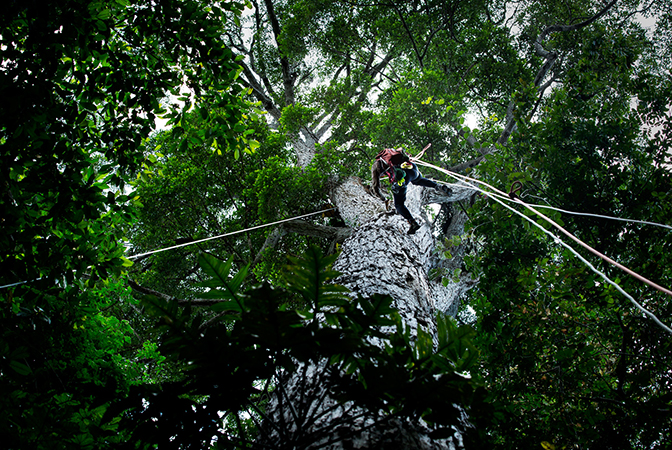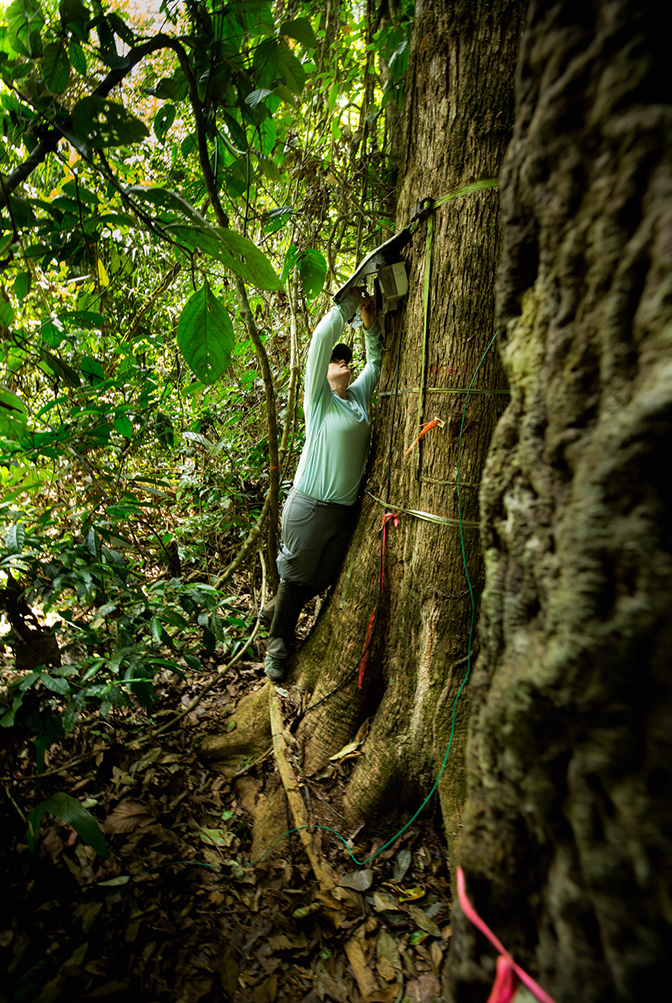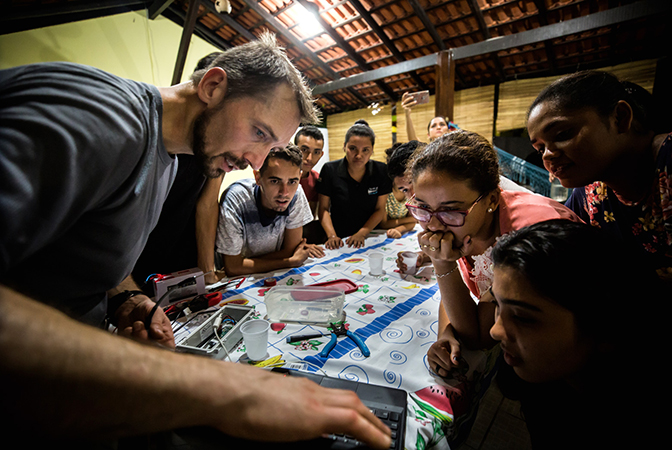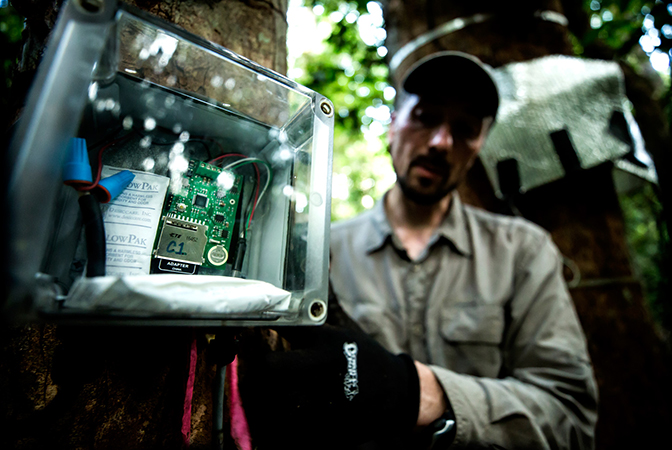
Solve for life
Racing to unlock the equations that could save the Amazon – and us all.

Racing to unlock the equations that could save the Amazon – and us all.
Photos by Joseph Xu

His feet dangling inches above the Amazon rainforest floor, Valeriy Ivanov looks up at the orange access line that snakes from his leather climbing harness into the massive erisma tree towering above him. He has his forest face on; a stubbled blue-eyed grin that toes the line between overjoyed and overwhelmed. He mops his forehead with a sweat-soaked shirt sleeve.
“OK, let’s climb.”
Ivanov ropes himself into a pair of cloth and leather footloops that clip to his access line. He grabs an ascending device called a jumar, which also clamps to the access line. And he’s up.
Pushing into the footloops and pulling on the jumar, he levers his body like an inchworm up the Y axis of Brazil’s Tapajos National Forest. Perhaps a dozen feet up, he clears the underbrush, climbing past the coussarea bushes and the whip-branched saplings of inga albas and ita ubas.
Higher now, 30 feet up. Thumb-thick liana vines wind around smooth red tree trunks. Ivanov swims through the air, the velvety-humid exhalations of uncountable leaves sliding across his skin.
70 feet. Yellow butterflies swarm purple-flowered jacarandas as the green-lit canopy comes into focus. The moss-mottled trunks of the forest’s biggest trees stretch downward and the air is a hissing, whining universe of insects.
100 feet. The University of Michigan ecohydrologist is a chandelier of multi-colored climbing gear swinging in a cathedral of forest. His view – the upper canopy of what is perhaps the world’s last great forest – is one that few humans will ever see. Ivanov, though, is here for the math.
The associate professor of civil and environmental engineering has come to this 50-acre research plot, sandwiched between Brazil’s Highway 163 and the Tapajos River about 90 minutes from the small port town of Santarém, to chase data.
“I walk through the forest and I see equations, I see the math,” he explains. “A tree is a pipe that moves water from the soil to the atmosphere. It has a valve at the end, and each tree uses that valve differently. Some of them, frankly, are doing things that don’t make sense to us. And we need to understand them.”
Valeriy is a maniac. He doesn’t sleep, and when he does sleep, he sleeps in trees.
Ivanov is the lone engineer on a team of about a dozen scientists – ecologists, mostly – who spend weeks at a time here collecting data. Funded by the National Science Foundation, their three-year project aims to develop a new understanding of an ecosystem that’s increasingly viewed as a lynchpin in the health of the planet.
Rope-walking in the canopy, climbing weather towers and picking their way along the forest floor, the researchers are surrounded by solutions: encoded into every fork of root, hue of leaf, uptake of carbon and outflow of water, they’ve been derived over eons to help a particular species wring life from the forest. Their goal is to collect these solutions, then work backwards to find the core equations that drive the forest’s life.
The project team includes researchers from several universities in addition to U-M, including the University of Arizona, Michigan State University, Harvard, and Brazil’s University of Campinas and Federal University of Western Para.
While their work is rooted in the fierce curiosity of scientists, the stakes are much higher than that. Over the coming decades, climate change will beget an Amazon rainforest that’s hotter and drier than at any previous point in human history. Understanding the math behind the forest could help modelers predict how it will change as the variables shift due to climate change. And those changes have implications far beyond the forest itself.
“The science of the Amazon is peculiar because it doesn’t just concern Brazilians or South Americans. It really concerns us all,” Ivanov said. “Changes to this region, for example, could alter precipitation patterns in North America. The atmosphere will change, the weather and climate will be impacted. So we really need to understand the fate of these forests in the face of the projected increase in droughts in this region.”
Today, the tools to build that understanding simply don’t exist. Biological variables like forest activity are one of the biggest unknowns in the massive models that attempt to predict the Earth’s climate decades from now. Mark Flanner, a U-M professor of climate and space sciences and engineering, explains.
“The modeling of biogeochemical feedbacks is still in its infancy,” he said. “How will the land and the ocean’s ability to absorb carbon change as the temperature and the amount of carbon dioxide in the air rise? We know, for example, that elevated carbon dioxide can enhance photosynthesis, but that can only occur if plants have adequate amounts of soil nutrients, water and light. And of course at some point plants simply get too hot for their chemistry to function properly. Each species has its own set of thresholds, so it’s an enormously complicated question.”
The answers can’t come quickly enough, as the Amazon faces increasing pressure from farming and mining interests, spurred on by Brazilian president Jair Bolsonaro, who seeks to open more of the forest to exploitation. Hard and fast data that predicts the consequences of that exploitation could be the key to maintaining a viable ecosystem, in the forest and on the rest of the planet.
I’m a nihilist on a bad day, an existentialist on a good day.
So Ivanov and the team spend their days fanned out high in the canopy, on the forest floor and in soil pits dug deep underground. They battle heat, humidity, rain, ants, lightning, snakes, chiggers and their own fatigue to keep the instruments running. At night, they gather under bare bulbs in the camp’s screened-in chow hall to sift through data, swap stories and try not to itch bug bites.
It’s an unusual choice for Ivanov; these days, modelers like him are more often found in front of computers than sweating it out in the field. But Ivanov has seen first-hand that equations can’t tell the whole story. The father of two got his first taste of the Amazon in 2005; the forest quickly showed him how little he knew.
“It’s just so intense,” he said. “The intensity is from everything – the temperature, the humidity, but most importantly from the diversity. It’s just mind-boggling how simply we represent plant life in the models.”
Ivanov also realized that the Amazon is perhaps Earth’s ultimate hydrological puzzle. Around one-fifth of all the fresh water that flows into the world’s oceans comes from the 200 mile-wide mouth of the Amazon river. That’s eight trillion gallons every day, 21 times the municipal daily water usage of the entire United States. And it’s estimated that Amazon rainforest plants move a still-larger volume of water from the ground to the atmosphere through evaporation.
Ivanov’s analytical perspective often puts him in the role of devil’s advocate as the team hashes out tactics. His 19-hour workdays have earned him the nickname “the crazy Russian.”
“Valeriy is a maniac,” jokes Neill Prohaska, a postdoc working under Scott Saleska, a University of Arizona assistant professor of ecology and evolutionary biology. “He’s always in the forest. He doesn’t sleep, and when he does sleep, he sleeps in trees.”

U-M civil and environmental engineering PhD candidate Elizabeth Agee works nearby on the forest floor. Wearing heavy black snake-proof leggings and a cordless screwdriver holstered to her hip, she swims red-faced through the heat, picking her way through the forest’s crush of life to inspect the sensors that measure, moment by moment, how much water flows through the forest’s trees.
Agee is replacing failed sap flow sensors with her latest iteration, a more durable version that draws far less power. Keeping even the hardiest electronics alive out here is a constant battle with heat, rain, humidity, ants, lightning and countless other hazards.
The business end of each sensor consists of two needle-like temperature probes that are inserted into the tree’s bark on one end and wired into a data logger on the other. Sap cools the probes as it flows past, and by measuring the temperature difference between the two, it’s possible to calculate the volume of water flowing through the tree.
By matching sap flow data to temperature, light, humidity and other data from the forest’s weather tower, the team can see how individual trees manage water in response to changes in their environment. And they’re finding that plants manage water and carbon in more complex ways than anyone imagined.
Scientists have known for decades that trees take in carbon dioxide and release water through tiny valves called stomata. Located on the surface of leaves, these stomata open and close to manage water and photosynthesis in response to their environment.
New measurements show that each species has its own strategy. Some shut down in times of drought, slowing photosynthesis to conserve water. Others live more dangerously, drawing on reserves of water to photosynthesize right through the drought’s sunny days. Understanding these strategies will be crucial to predicting how the forest will respond to a changing climate.
That’s where the sensors come in.
“I feel a personal connection to every sensor out here,” Agee says. “And when one fails, I feel personally responsible.”
That’s because Agee builds each sensor by hand in the basement of the Northwood V apartment she shares with her husband and two children. It’s a matter of necessity because, as she and Ivanov have learned over several years of sweltering trial and error, no commercially available sap flow monitor can survive the Amazon.
So Agee built a better one, learning to solder custom-made circuit boards, threading hair-thin thermocouple wires through hollow probe needles and sealing probe wires inside the repurposed insulation of Cat-5 Ethernet cable. The parts for the hand-built sensors are about one-tenth the cost of the commercial versions, and their extra armor gives them a fighting chance in the forest.
“Technology used to seem mystical to me,” she said. “I thought it must have been made by incredibly smart people and I’d never understand it. But once you start making things, you see that it’s not really that complicated. You think ‘oh, I can do this.’”
The sap flow sensors are perhaps Agee and Ivanov’s single most important data collection tool, and Ivanov won’t trust the delicate operation to anyone else.
Agee uses a long metal pole to gingerly poke at a square of silver insulation that blankets a sap flow sensor strapped to the side of a tree. The brim of her U-M baseball cap angles up as she lifts a corner, peeking underneath with a grimace. The lime-green head of a gecko pops out, looking around warily.
“Oh, hello gecko!” she laughs. “I like geckoes because they eat the things that want to hurt me.”
Agee has traveled a long road to get here, beginning in 2010 when she became the first member of her family to go to college. Growing up in central Indiana, she was always bookish compared to her brothers, and briefly attended college at North Carolina State University, working full-time to support herself. She eventually dropped out and moved home to take care of her father, who was in poor health. During that time, she gave birth to her son.
She got by working a series of retail jobs; it was a living, but over time, she was struck by the physical and emotional toll the job took on her co-workers. She decided to see what was available at nearby Indiana University-Purdue University Indianapolis. Ultimately, she chose physics, taking out loans and working to support herself as she finished her undergraduate degree in two years.
“I didn’t want retail to be my life,” she said. “And maybe even more than that, I wanted my son to see that life holds other possibilities.”
Unholstering her screwdriver, Agee backs out the four screws that seal the sensor’s control box. Inside is an Arduino processor sandwiched onto a custom-built circuit board. The board feeds data from the temperature probes into an SD card.
Agee unscrews the three tiny set screws that connect the board’s wires and pulls it away from the Velcro square that holds it into the box. She Velcros in the new board, connects its wires and re-seals it underneath the box’s plastic cover. Finally, she replaces the silver bubble wrap, blanketing the gecko who’s hiding in the space between the box and the tree trunk.
“Goodbye, my friend. I’ll try not to disturb you for a while.”
Agee will complete her PhD in June of 2019; she hopes to become a university professor. Her departure will leave Ivanov without the partner who has accompanied him on three years of trips into the Amazon.
“Doing university research is kind of like running an eternal startup,” Ivanov said. “Things are always changing, the workload is distributed unevenly, and there are challenges that are unique to your ‘business’ that are hard or even impossible to meet.”

Replacing Agee will not be easy. But if Ivanov wants to keep his part of the project alive, he has no choice. That’s why, earlier in the trip, he found himself bouncing through the streets of Santarém in the passenger seat of a red Fiat hatchback driven by Raphael Tapajos, a professor in the four-year-old meteorology program at the Federal University of Western Pará (UFOPA).
As early-afternoon heat began to press down on Santarém’s red-dusty streets, the two drove to UFOPA to give a talk aimed at stoking graduate students’ interest in working in the forest.
Santarém has grown quickly in recent years, with a brand-new shopping mall fueled by the oil boom of the early 2010s and by the World Cup soccer matches that were held recently in nearby Manaus. But it’s still a remote, rural town that holds the dusty and precariously human air of a place caught between two eras. A modern-looking off ramp guides a mix of cars, motorcycles and horse-drawn wagons from Brazil’s Highway 163 to Santarém’s sunbaked main street.
The people I teach here will eventually teach others.
UFOPA’s Santarém campus is the nearest university outpost to the research forest, only about a 90-minute drive on good, paved roads. But in a country focused on modernization, climbing trees and dodging snakes in a remote northern town isn’t an enticing option for many students.
“When people come to Santarém, they think they’re going to see jaguars and snakes in the streets,” said Tapajos, who grew up here. “People in the south don’t recognize the importance of the forests, but the rain they get comes from the forests here.”
Tapajos sees the meteorology program as an opportunity to pursue a more research-oriented future for UFOPA, driving a better understanding of the forest and its role in the Earth’s climate.
“We need to develop technology to manage and adapt to the climate, and I think it’s important for people who are from here to play a role,” he said. “We’re in the middle of the forest and we need to understand it, we need to apply our knowledge. The people I teach here will eventually teach others.”
Given the current political climate in Brazil, that’s likely to be an uphill battle. In addition to Brazilian president Jair Bolsonaro’s efforts to roll back forest protections, the country is feeling the effects of a 2016 austerity bill that’s perhaps the world’s most extreme. It freezes government spending at inflation-adjusted 2016 levels for the next 20 years, with no provisions for population growth, recession or other possible eventualities.
“We’re in a bad moment in research. There have been a lot of financial cuts, and the government may also cut the protection of the forest,” he said. “I don’t know what will happen, and that worries me.”

“MONKEYS!”
Back in the forest, Ivanov’s voice crackles through the trees, echoing from the two-way radios worn by the research team. Still working overhead in the erisma, he has encountered a family of howler monkeys. They’re often heard but seldom seen, so a sighting is a noteworthy event.
“It’s a mama and baby and, oh, here’s papa!”
The monkeys are a much-needed distraction from the late-afternoon heat. The two hours from 3 p.m. to 5 p.m. are the hottest part of the day, when sweaty clothes hang heavy on the already-weary crew. But with the heat comes beauty; late-afternoon sunlight congeals into thick bands that spike through the trees, silhouetting birds and butterflies as the rays change from yellow to orange to red to purple to blue with the sinking of the sun.
Michigan State University department of forestry assistant professor Scott Stark has taken refuge from the heat in the tiny, mint-green concrete building the crew refers to simply as “the shack.” Beyond its heavy steel door, it offers workbenches, Wi-Fi and, perhaps most importantly, the only air conditioning anywhere in the camp.
Behind a wall of cool sits Stark, his lanky climber’s body folded onto a wooden stool. He’s studying a spreadsheet on his laptop with half-lidded eyes and a laconic smirk.
Stark has spent much of the day climbing trees in the upper canopy, where he’s setting up six monitoring stations that will measure the environments immediately surrounding leaves. This will uncover important details about how leaves in different parts of the forest manage photosynthesis and respiration. He’s also charged with weaving the project’s data together into a cohesive model.
“What we’re doing is unifying the different scales that we have in this project,” he explains. “We have all these different types of measurements, we have a few processes that we can observe. And on the far end, we want to turn them into predictions about how the forest will behave. Those predictions will be the ultimate outcomes and objectives of this project.”
Stark is optimistic about the new knowledge that will be uncovered at the end of the three-year project. He’s less certain about how effectively that knowledge will be put to use. Brazil has been more proactive and successful than any other country in the area of forest management, dramatically reducing the rate of deforestation in the Amazon from its peak in the early 2000s.But in a worrying trend, deforestation has begun to tick up again in recent years. Stark, like the rest of the crew, does his best to keep things in perspective.
“I’m a nihilist on a bad day, an existentialist on a good day,” he said. “This is what the Earth is going through right now. We’re witnessing a unique moment in its history and I just hope that what we’re doing here can contribute to some level of stability for the planet.”
Outside the shack, Deliane Penha sits in a plastic chair, exhausted after a day of climbing in the canopy. The sun has set and the temperature has gone from stifling to merely hot. The silky night air is thick with the sounds of insects and luminescent flying termites prick the darkness with hovering points of white light.
A PhD candidate at UFOPA, Penha spends her days here climbing into the network of walkways that snakes through the forest canopy, clamping a device called a porometer onto leaves to measure their respiration.
Originally from Obidos, a small town on the other side of the Amazon river, Penha began interning with the crew as an undergraduate, stepping into the forest for the first time at age 23 and later returning to forest work as a PhD candidate. Speaking through an interpreter, she explains that she fell in love with ecology, and working toward her PhD has only made her more curious.
“I get more and more interested in the forest and how it works – how, for example, vegetation will respond to climate change,” she said. “It’s a big global question, and I hope I can make some contribution to it.”
But like the others, she’s unsure of her future, especially given Brazil’s recent troubles. She’d like to become a professor, but lately she has been thinking about teaching high school as academic opportunities in Brazil have waned.
“The work is like a Samba – a mixture of emotions,” she said. “Here, there is enormous uncertainty in every step, constant challenges and hard work. But knowing that you’re contributing to science and that you’re finding not just new answers but new questions is amazing,” she said.
Penha has a boy of six, and two girls, ages nine years and nine months. She takes the older children to the forest often and has watched their appreciation for it grow over the years.
“They think it’s really cool that their mom works in the woods and climbs trees,” she said. “They look up to me, and that alone is enough to justify what I do here.”

As difficult as it is, Penha considers it an honor to work in the forest, finding that it spooks and awes her in equal measure.
“When I climb a tree, the first feeling I have is fear,” she said. “I can’t see anything and I imagine myself dying. But then there’s a second feeling. You’re in awe of the tree and it reminds you how insignificant you are. You feel vulnerable, dangling in this crazy world where people are trying to tear everything down. And you wonder whether you’re doing enough to stop it.”